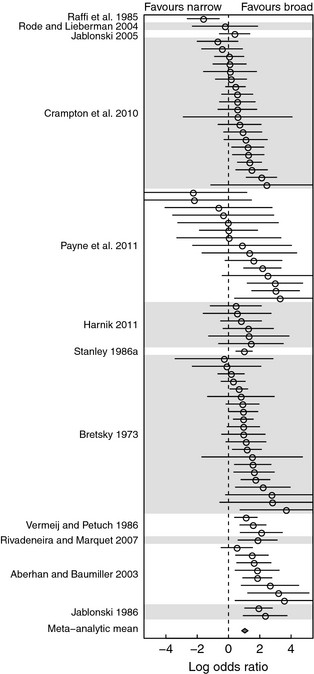Marine extinction risk shaped by trait–environment interactions over 500 million years
Orzechowski, E.A., R. Lockwood, J.E. Byrnes, S.C. Anderson*, S. Finnegan, Z.V. Finkel, P.G. Harnik, D.R. Lindberg, L.H. Liow, H.K. Lotze, C.R. McClain, J.L. McGuire, A. O’Dea, J.M. Pandolfi, C. Simpson, D.P. Tittensor. Marine extinction risk shaped by trait-environment interactions over 500 million years. 2015. Global Change Biology. 21(10): 3595–3607. doi: 10.1111/gcb.12963
Perhaps the most pressing issue in predicting biotic responses to present and future global change is understanding how environmental factors shape the relationship between ecological traits and extinction risk. The fossil record provides millions of years of insight into how extinction selectivity (i.e., differential extinction risk) is shaped by inter- actions between ecological traits and environmental conditions. Numerous paleontological studies have examined trait-based extinction selectivity; however, the extent to which these patterns are shaped by environmental conditions is poorly understood due to a lack of quantitative synthesis across studies. We conducted a meta-analysis of pub- lished studies on fossil marine bivalves and gastropods that span 458 million years to uncover how global environ- mental and geochemical changes covary with trait-based extinction selectivity. We focused on geographic range size and life habit (i.e., infaunal vs. epifaunal), two of the most important and commonly examined predictors of extinc- tion selectivity. We used geochemical proxies related to global climate, as well as indicators of ocean acidification, to infer average global environmental conditions. Life-habit selectivity is weakly dependent on environmental condi- tions, with infaunal species relatively buffered from extinction during warmer climate states. In contrast, the odds of taxa with broad geographic ranges surviving an extinction (>2500 km for genera, >500 km for species) are on average three times greater than narrow-ranging taxa (estimate of odds ratio: 2.8, 95% confidence interval = 2.3–3.5), regard- less of the prevailing global environmental conditions. The environmental independence of geographic range size extinction selectivity emphasizes the critical role of geographic range size in setting conservation priorities.
